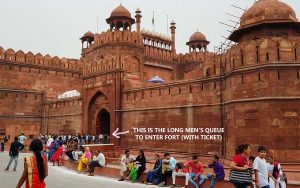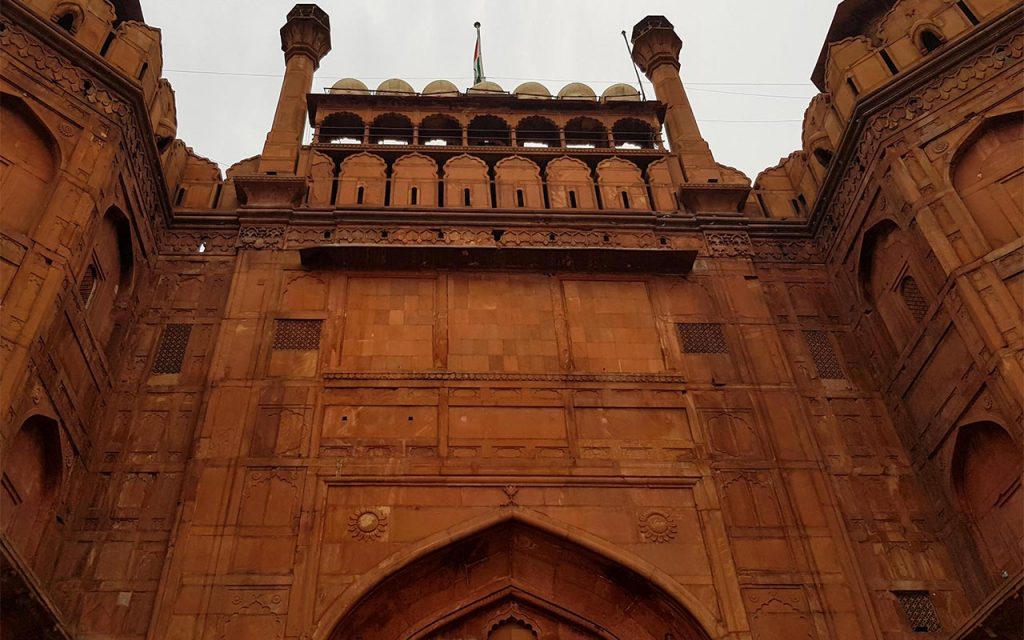At the end of a six-day working week, staying and working in the Taj Mahal Hotel, New Delhi, a peaceful, luxurious five star hotel, my friend and I had the Sunday off and decided to visit the Red Fort. Around the hotel are wide, tree-lined streets with an idyllic abundance of squirrels, birds, trees and flowers and the only awareness of being in India’s capital city is some traffic noise and tooting from vehicles beyond the high fences around the pool and grounds.
I’m a huge fan of Delhi’s metro system and it’s a ten-minute walk from the Taj Mahal Hotel (it would be less without having to cross quite a few roads without pedestrian lights – an introduction to what’s ahead) to Khan Market station, on the same line as Lal Quila/Red Fort station.
We emerged from the Metro at Lal Quila.
You know that little yellow “street view” man you can drag from the corner of a Google Maps page to a street you want to see as immersive photos? Arriving at Lal Quila is kind of like that, it feels like you’ve been snatched and plonked somewhere against your will that you are completely unprepared for. And that particular drop-off point epitomises chaos, far removed from the quiet, safe little corner of the Google Maps page or the oasis of a luxury five star hotel.
I reiterate that we visited on a Sunday, possibly the busiest day to go to a tourist site in India. In our case it was also a very hot, overcast, humid August day.
Top 8 Lal Quila Culture Shocks
1. The population of London is c8.8 million, Delhi is c25 million. It can feel like a significant proportion of the Delhi population is at Lal Quila.
2. If you are, for example, white British (as my friend and I are), to many people you are different and thus interesting. More Indians than you might expect, either surreptitiously, blatantly or by asking politely, will take your photograph. Even if it’s August, you’re sweating profusely and look hideous.
3. There is a ladies’ queue to pass through security. Most tourists are men. The short ladies’ queue is not too good to be true. Enjoy it, assuming you are also a lady.

4. You are a foreign tourist. You will pay more (for everything, really) to enter Lal Quila. I once queued at the cheaper locals’ ticket booth in error at another tourist site, Qutub Minar. I was asked, “Are you Indian?”, I said, “No.” I was directed to the special foreign tourist counter, where I paid roughly 15 times more than locals. Live with it. Or see what happens if you say “Yes”?! Lal Quila is about 550 IRP but the prices changed recently; it’s around that.
5. Lal Quila is a UNESCO World Heritage Site and features on the 500 rupee bank note. Inside the complex, vast areas areas are unkempt, rundown and/or health and safety no-go areas by UK standards.
6. Outside the fort there may be seemingly thousands of people crowded around. Inside, it being far, far bigger than you probably realise, the crowds disperse significantly and somehow it’s almost calm.
7. The road in front of Lal Quila is extraordinary for its busyness. You may want to cross it, for example to get to/from Chandni Chowk or Chandni Chowk Metro station. There are traffic lights but the multiple layers (“lanes” would imply a degree of order) of various forms of vehicle/animal/transport are so dense that the likelihood of crossing seems impossible. As you’re jostled, you will become aware that there are tens and tens of other people also trying to cross the road next to you. Then, somehow, en mass, you all get across in one piece. The thrill, astonishment and relief of having crossed a road is the culture shock element more than the sheer amount of traffic and associated noise!
8. Toilets. A pay-to-visit tourist site with thousands of visitors, you’d expect toilet facilities. We saw signs to them. We didn’t find them. I get the impression there are none, though I believe they will feature after the work currently going on at the site is finished. I reiterate, it’s a vast site with thousands of visitors and you could easily spend hours there. Work on the assumption there are no toilets.
Top 10 pieces of advice ahead of entry into Lal Quila
1. Go early. Check opening times (I am fairly sure it’s 9.30am – 4.30pm, CLOSED on Mondays). Apparently, it gets busier and busier throughout the day. Ideally don’t go on a Saturday, Sunday or public holiday unless you thrive on crowds.
2. There is only one operational entrance/exit, which is the one by Lal Quila Metro Station.
3. Ignore all queues for tickets, the “foreign visitor” booth is likely to have no queue and local visitors kindly and readily pointed us in the direction of the foreigner booth; it may look like you’ll never find it/get through the queues but you will be out of there before you’ve even had a chance to absorb the length and chaos of the locals’ queue.
4. Bring plenty of water, especially if it’s hot; most of the interior of the fort is outdoors and not covered (but there are trees and walkways for respite from the sun). There also appear to be no refreshment stalls anyway.
5. Take advantage of any pre-entry toilet opportunities (eg hotel, restaurant, cafe).
6. The ladies’ security check point is to the left as you prepare to enter the fort. Don’t go thinking you’re going the wrong way if there is no queue. Anyway, remember how much you paid for your entry ticket compared to most other visitors.
7. The main road in front of Lal Quila and at the entrance/exit to the Metro is bewilderingly busy, with vehicles, animals (yes, really, but not always), people, street vendors and bewildered foreign tourists. If you don’t take the Metro because you think it might be busy/scary; it isn’t, especially compared with being deposited outside Lal Quila by auto rickshaw or taxi. Do not underestimate how crazy busy it can be.
8. Apparently pick pocketing can be an issue. Despite all the people around, I didn’t feel threatened or unsafe but in such a potentially busy and chaotic environment, it’s obvious to pay attention to your belongings.
9. Don’t panic. It somehow all works out fine.
10. There are guides of varying degrees of officialdom and knowledge who will offer to guide you, of course for a fee. Decide before you go whether you’ll want a guide so if you decide “no” you can be forceful and confident with your “no, thank you” rather than dithery and thus worth pestering, from a guide’s perspective, in your rejection of offers to guide you. If you want a guide, ask to see their badge, make a judgement call and/or trust your instincts. Do not feel bad saying no if the guide doesn’t fill you with confidence. Walk away.
If you decide to take a guide, agree a price before you accept their offer.
At the Taj Mahal, another friend and I had a guide (and wished we hadn’t) and were told the payment was a tip, we could pay what we liked. We gave him 500 IRP, which he clearly didn’t feel was sufficient. There are audio guides and/or an app you can download but I have not downloaded them or know anyone who has used them so I do not know what they are like.
We didn’t have any kind of guide. There are signs around the site, but I am aware we would have learned a lot of interesting things had we either read about the fort beforehand or had a guide with a genuine knowledge of the fort’s history, and I reiterate “genuine” because I have heard some extraordinarily creative “facts” that even I know are wrong, and my knowledge of Indian history and culture is limited. If I went again I would probably try the app and/or read more about the history and architecture of the fort. I personally would not use a guide, for reasons which I could write a long blog post about.
8 reasons to visit Lal Quila/the Red Fort
1. The more you learn about its history, the more you can appreciate this is a hugely significant building to India, Indian people and Indian culture.
2. It’s cool to visit somewhere pictured on a unit of money, the 500 rupee note.
3. It is far, far bigger than you can comprehend from outside and that fact alone is worth witnessing; it is a veritable walled city.
4. Some of the architectural details are exquisite and make lovely photographs.
5. People-watching opportunities are in abundance due to the high number of visitors, the setting and the variety of selfie poses on display.
6. A reminder of life in the UK before health and safety took away a lot of (sometimes dangerous) fun.
7. To see how familiar versus truly Indian so much of the architecture is.
8. It’s definitely not my favourite and not the prettiest tourist attraction in Delhi but it’s worth seeing for all of the above and locals I have spoken to seem really happy and proud when you say you have visited the Red Fort.
